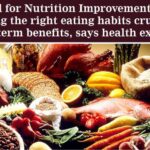Nutrition for Toddlers – important part of a toddler’s diet is calcium and the best source of nutrient is milk. Breast-milk has a readily-absorbed type of iron.
Healthy eating for toddlers and young children


Depending on age, size, and activity level, your toddler needs between 1,000-1,400 calories a day. It is perfectly normal for your child to be ravenous one day and shun food the next. Don’t worry if your child’s diet isn’t up to par every day—as long as he or she seems satisfied and is getting a well-rounded diet.
Nutritional needs of toddlers and young children
An important part of a toddler’s diet is calcium (they need about 500 mg/day), and the best source of this nutrient is milk. Until the age of two they should drink whole milk, but older toddlers can usually switch to 2% or skim milk if approved by your paediatrician. If your kids are lactose intolerant or don’t like dairy, incorporate calcium-rich foods like fortified soy products, cereals, and orange juice.
Toddlers need 7 mg a day to prevent iron deficiency, which can affect growth, learning, and behaviour. In infancy, breast-milk has a readily-absorbed type of iron, and baby formula and food is usually iron-fortified, so babies don’t need to worry about getting enough iron. After switching to “real” food, it’s important to ensure that your child is eating good sources of iron like fortified cereals, small amounts of red meat (like soft meatballs), or eggs.
Dietary guidelines for toddlers and young children
| Fruits and vegetables | Two servings each per day. These may be given as snacks, such as apple or carrot slices. Also try adding veggies to soups |
| Whole grains | Four daily servings. Can include buckwheat pancakes or multigrain toast for breakfast, a sandwich on wheat bread for lunch and brown rice or another whole grain as part of the evening meal. |
| Milk and dairy | Three servings, or one pint of whole milk per day. Cheeses, yogurt, and milk puddings are useful alternatives. |
| Protein | Two servings a day. Encourage your child to try a variety of proteins, such as turkey, eggs, fish, chicken, lamb, baked beans, and lentils. |
| Vitamins and minerals | Check with your child’s doctor to be certain their diet is adequately meeting the recommended nutritional needs for this age group |
Healthy diets for school-age children
Eating becomes a social activity in this stage of life. Your kids probably spend more time in school than they do at home; eat meals at friends’ houses; and adopt eating habits from their peers. It can be difficult to ensure they are getting adequate nutrition when you are not around to monitor their choices, so try to maintain regular family mealtimes.
For kids aged 5-12, the key word is variety. Creative serving ideas will go a long way towards maintaining the healthy eating habits established in the first years of life.
Not only do family meals provide an opportunity to catch up on your kids’ daily lives, they also enable you to “teach by example.” Let your kids see you eating a wide variety of healthy foods while keeping your portions in check. Refrain from obsessive calorie counting, though, or commenting on your own weight, so that kids don’t adopt negative associations with food.
Nutrition guidelines for school-age kids
As children develop, they require the same healthy foods adults eat, along with more vitamins and minerals to support growing bodies. This means whole grains (whole wheat, oats, barley, rice, millet, quinoa); a wide variety of fresh fruits and vegetables; calcium for growing bones (milk, yogurt, or substitutes if lactose intolerant); and healthy proteins (fish, eggs, poultry, lean meat, nuts, and seeds).
Healthy fats are also important:
- Monounsaturated fats, from plant oils like canola oil, peanut oil, and olive oil, as well as avocados, nuts (like almonds, hazelnuts, and pecans), and seeds (such as pumpkin, sesame).
- Polyunsaturated fats, including Omega-3 and Omega-6 fatty acids, found in fatty fish, such as salmon, herring, mackerel, anchovies, and sardines, or in unheated sunflower, corn, soybean, and flaxseed oils, and walnuts.
Kids, should limit:
- Trans fats, found in vegetable shortenings, some margarines, crackers, candies, cookies, snack foods, fried foods, baked goods, and other processed foods made with partially hydrogenated vegetable oils.
Dietary guidelines for school age children
| Vegetables
|
3-5 servings per day. A serving might be one cup of raw leafy vegetables, 3/4 cup of vegetable juice, or 1/2 cup of other vegetables, raw or cooked. |
| Fruits
|
2-4 servings per day. A serving may consist of 1/2 cup of sliced fruit, 3/4 cup of fruit juice, or a medium-size whole fruit, such as an apple, banana or pear. |
| Whole Grains | 6-11 servings per day. Each serving should equal one slice of bread, 1/2 cup of rice or 1 ounce of cereal. |
| Protein | 2-3 servings of 2-3 ounces of cooked lean meat, poultry, or fish per day. A serving in this group may also consist of 1/2 cup of cooked dry beans, one egg, or 2 tablespoons of peanut butter for each ounce of lean meat. |
| Dairy products | 2-3 servings (cups) per day of low-fat milk or yogurt, or natural cheese (1.5 ounces=one serving). |
| Zinc | Studies indicate that zinc may improve memory and school performance, especially in boys. Good sources of zinc are oysters, beef, pork, liver, dried beans and peas, whole grains, fortified cereals, nuts, milk, cocoa, and poultry. |
Dietitian, Certified Diabetes Educator












